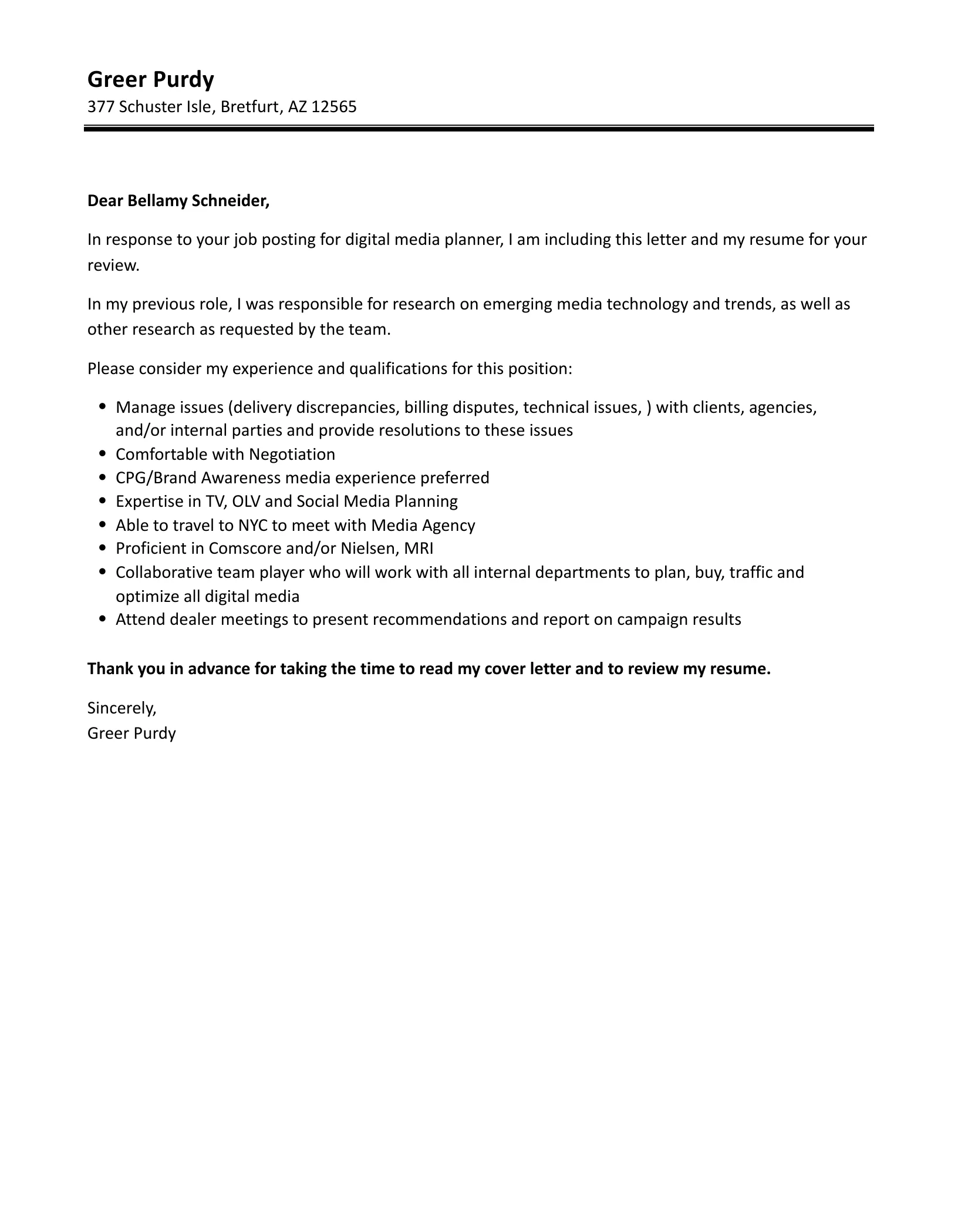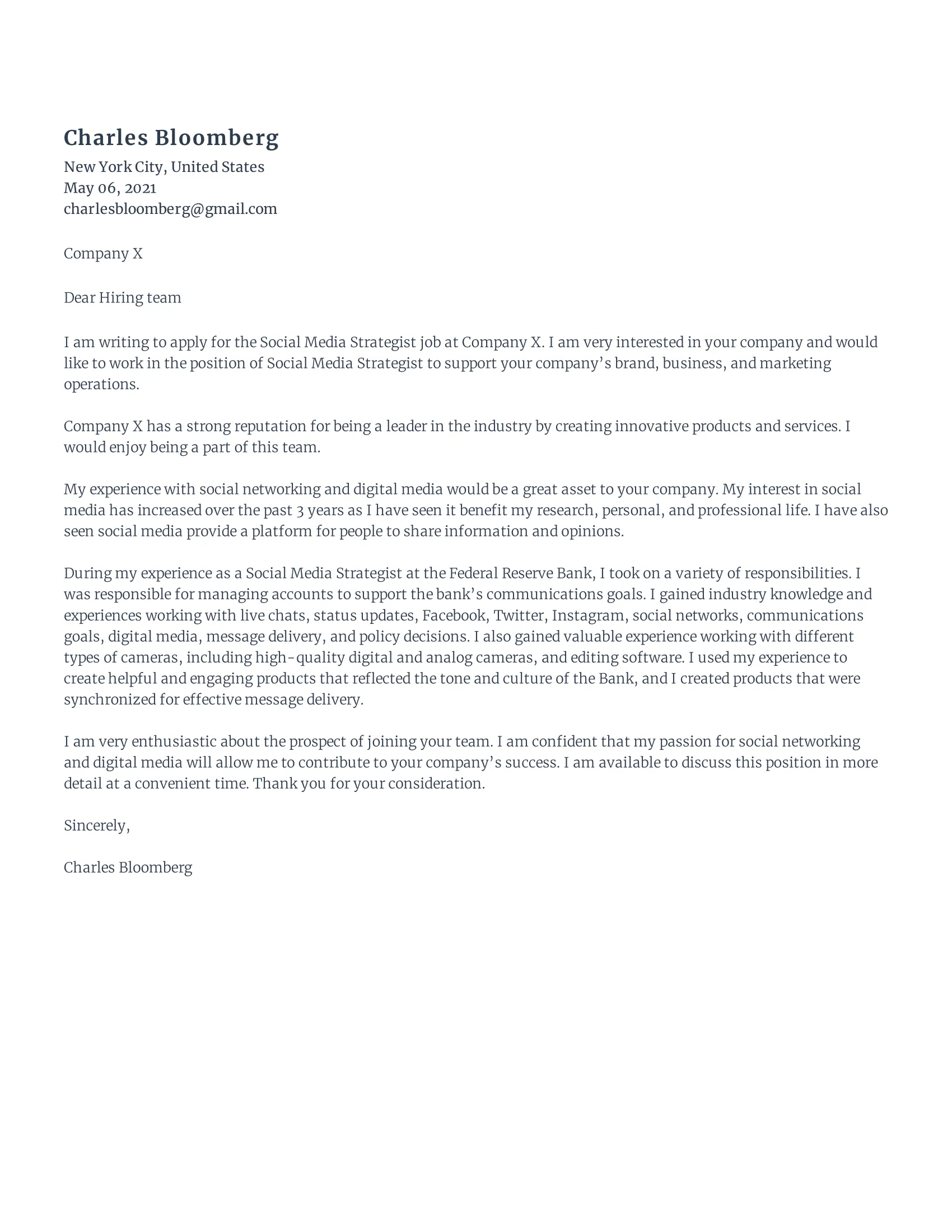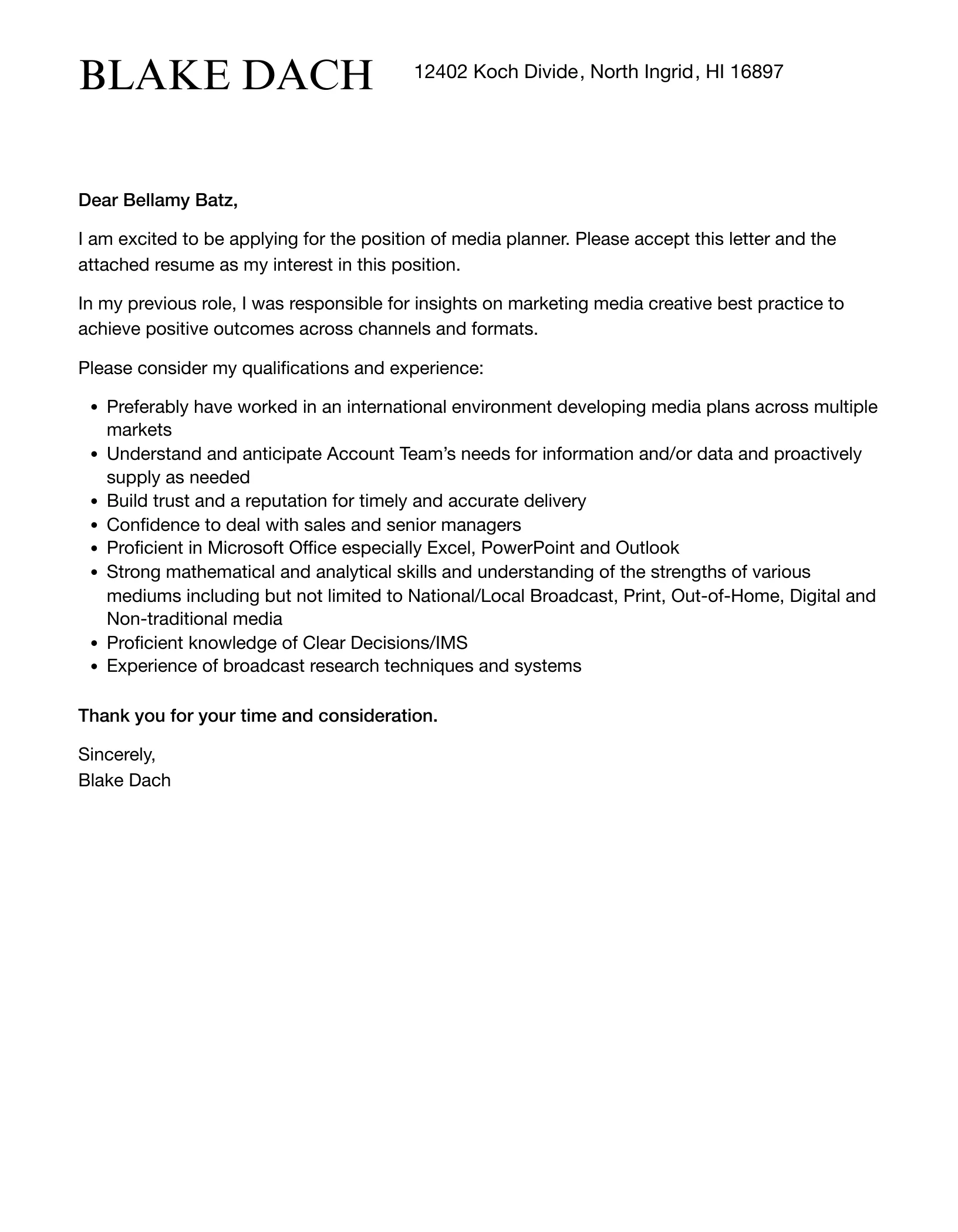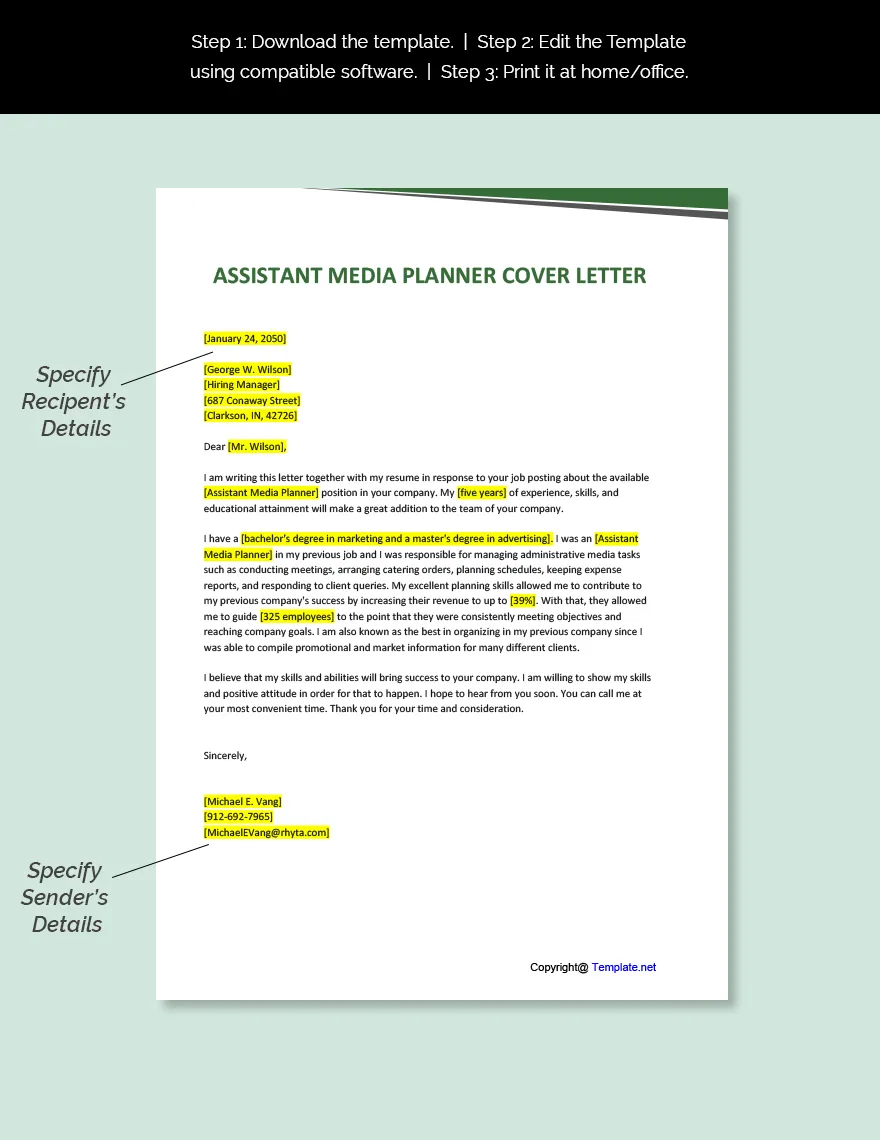Why a Media Planner Cover Letter is Crucial
In the competitive world of media planning, a well-crafted cover letter is your first opportunity to make a lasting impression on potential employers. It’s more than just a formality; it’s your chance to tell your story, showcase your unique skills, and demonstrate why you’re the perfect fit for the role. Unlike a resume, which provides a snapshot of your experience, a cover letter allows you to explain your motivations, connect with the hiring manager on a personal level, and highlight the specific reasons why you’re interested in the company and the position. Neglecting this crucial step could mean missing out on opportunities, so understanding how to write an impactful cover letter is paramount to securing your dream media planning job. A compelling cover letter allows you to elaborate on your resume and provide context to your achievements.
Crafting a Compelling Header
The header of your cover letter sets the tone for the entire document, and it needs to be professional and visually appealing. Begin with your full name, contact information (phone number, email address, and LinkedIn profile URL), and the date. Then, include the hiring manager’s name (if you know it) and title, as well as the company name and address. If you can’t find the hiring manager’s name, use a general greeting like ‘Dear Hiring Manager’. Ensure the header is well-organized and easy to read, as this section provides critical information at a glance. Using a clean font and appropriate spacing contributes to a polished look, presenting you as detail-oriented and professional. A well-designed header also immediately signals that you’ve taken the time to prepare a thoughtful application, making a positive first impression and encouraging the reader to continue to the body of your letter.
Your Contact Information

Your contact information is crucial because it allows potential employers to reach you easily. Make sure to include your full name, phone number, professional email address, and LinkedIn profile URL. Double-check that your contact details are accurate and up-to-date to avoid any communication issues. Using a professional email address, rather than a casual or outdated one, helps project a sense of professionalism and credibility. A LinkedIn profile URL provides additional context, allowing the hiring manager to view your professional background and network. Verify your voicemail greeting is professional. Ensure that your contact details are easy to find, and the inclusion of this information ensures that you are accessible for interviews and further communication, boosting your chances of progressing in the application process. Having accessible, accurate, and professional contact information is a basic requirement.
The Recruiter’s Contact Information
Researching and including the recruiter’s or hiring manager’s contact information in your header demonstrates attention to detail and a proactive approach. If you know the specific person who will be reviewing your application, address your cover letter to them. You can often find this information on the job posting or the company’s website. If a name isn’t listed, you can often find it on LinkedIn. Addressing the letter to a specific individual personalizes your application and shows that you’ve done your homework. It creates a more personal connection and demonstrates your genuine interest in the position. When you can, tailor the letter to show you know who you are speaking to. Even if you don’t know the specific person, try to find out who the hiring manager is to create the best cover letter possible.
Writing an Engaging Opening Paragraph
The opening paragraph is your first opportunity to grab the reader’s attention and set the tone for the rest of your cover letter. Start with a strong, engaging statement that immediately captures the hiring manager’s interest. Mention the specific position you’re applying for and how you found the job listing. Then, briefly highlight your most relevant skills and experience. Consider including a brief statement about why you are excited about the role and the company. Tailor your opening paragraph to demonstrate genuine enthusiasm for the specific position and company. This is your chance to make a strong first impression and entice the reader to continue reading the rest of your application. Avoid generic opening statements, and instead, show your personality. The opening needs to be impactful.
Highlighting Your Media Planning Skills

In the body of your cover letter, focus on showcasing your media planning skills and how they align with the requirements of the job. Mention your experience with media buying, campaign management, budget allocation, and performance analysis. Use specific examples to illustrate your skills, providing tangible evidence of your accomplishments. Quantify your achievements whenever possible, such as the percentage increase in campaign performance or the cost savings achieved through strategic media planning. Tailor your skills to match the job description, emphasizing the qualities and experiences that the employer is looking for. Demonstrate a deep understanding of the industry and how you can contribute to the company’s success by highlighting your key strengths. Being able to make an impact is key to a solid media planning cover letter.
Quantifiable Achievements
Instead of simply listing your responsibilities, use your cover letter to highlight your quantifiable achievements in previous roles. Provide specific examples of how your media planning strategies have led to measurable results. Use numbers and data to illustrate your successes, such as increasing campaign ROI by a certain percentage, reducing media costs, or improving engagement rates. For example, you could state, ‘In my previous role, I increased campaign ROI by 15% through strategic audience targeting and media channel optimization.’ Or, you could say, ‘I reduced media costs by 10% by negotiating favorable rates with vendors.’ Quantifiable achievements provide tangible evidence of your skills and experience and make your cover letter stand out from the competition. Quantifying your success makes a lasting impact.
Showcasing Your Knowledge of Media Channels
As a media planner, it is crucial to demonstrate your expertise in a wide range of media channels. Your cover letter should showcase your familiarity with both traditional and digital media platforms, including TV, radio, print, social media, search engine marketing, and programmatic advertising. Highlight your experience with various media planning tools and platforms. Mention any certifications or training you’ve received related to specific media channels. Provide concrete examples of how you have successfully planned and executed campaigns across different media channels. This demonstrates your versatility, adaptability, and a deep understanding of the current media landscape. Being able to handle various media channels is key to success.
Demonstrating Your Passion and Enthusiasm

A cover letter is your opportunity to show your passion and enthusiasm for media planning and the specific company you are applying to. Explain why you are interested in the role and what excites you about the company’s mission and values. Research the company beforehand and demonstrate your understanding of its brand and target audience. Express your genuine excitement about the opportunity to contribute to their success. Personalize your cover letter to reflect your interest, and avoid using generic statements that could apply to any job. Demonstrate your drive and ambition by expressing a genuine interest in the company, and your excitement about the opportunity to help them achieve their goals. Enthusiasm helps get you hired.
The Importance of a Strong Closing Paragraph
The closing paragraph is your final chance to leave a lasting impression on the hiring manager, so it is important to end on a strong note. Reiterate your interest in the position, and summarize why you are the best fit for the role. Clearly state your intention to follow up and express your gratitude for the opportunity to be considered. Thank the hiring manager for their time and consideration, and provide your contact information again. End with a professional closing, such as ‘Sincerely’ or ‘Best regards,’ followed by your full name. Ensure the closing paragraph is concise, professional, and leaves the reader with a positive impression. The way you close the letter can impact your potential interview, so be sure to leave a lasting impression.
Proofreading and Editing Your Cover Letter
Before submitting your cover letter, take the time to proofread and edit it thoroughly. Check for any grammatical errors, spelling mistakes, or typos. Ensure that your sentences are clear, concise, and well-structured. Read your cover letter aloud to identify any awkward phrasing or sentences that don’t flow well. Consider asking a friend, family member, or career advisor to review your cover letter and provide feedback. A polished and error-free cover letter demonstrates your attention to detail and professionalism. Proofreading and editing are the final steps in creating a compelling cover letter that will make a lasting impression. Make sure you carefully check the letter to make sure that it is ready to be read by the hiring manager.
